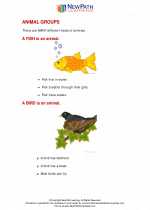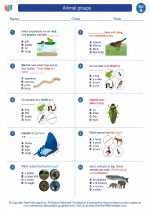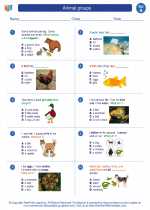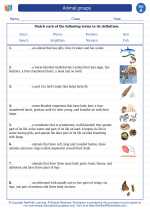Animal Groups
Animals can be grouped in different ways based on their characteristics and behaviors. Understanding these groups helps us classify and study animals more effectively.
Vertebrates and Invertebrates
Animals can be classified as vertebrates or invertebrates. Vertebrates have a backbone or spinal column, while invertebrates do not.
Examples of Vertebrates:
- Fish
- Amphibians
- Reptiles
- Birds
- Mammals
Examples of Invertebrates:
- Insects
- Worms
- Spiders
- Crustaceans
- Mollusks
Animal Classes
Within the vertebrate group, animals are further classified into different classes based on their characteristics and evolutionary relationships.
Example Classes of Vertebrates:
- Class Mammalia: includes animals that have hair or fur, produce milk to feed their young, and have a diaphragm separating the chest and abdominal cavities.
- Class Aves: includes animals with feathers, wings, and beaks, and most of them lay eggs.
- Class Reptilia: includes animals that are cold-blooded, have dry scaly skin, and lay eggs with tough shells.
- Class Amphibia: includes animals that are able to live both on land and in water, and typically have moist skin.
- Class Osteichthyes: includes bony fish, which have scales and gills for breathing.
Social Behavior and Grouping
Animals also form groups based on their social behavior and interactions with other members of their species. These groupings can include herds, packs, colonies, flocks, and schools.
Example Social Groups:
- Herd: a group of grazing herbivores such as deer or antelope.
- Pack: a group of wolves or wild dogs that live and hunt together.
- Colony: a community of animals such as ants or bees that live and work together.
- Flock: a group of birds such as geese or pigeons that fly and feed together.
- School: a group of fish that swim together in coordinated patterns for protection and finding food.
Study Guide
Use the following questions to guide your study of animal groups:
- What are the main differences between vertebrates and invertebrates?
- Can you name one example of an animal from each of the vertebrate classes?
- How do animals benefit from living in social groups?
- What are some examples of social groups formed by animals, and what are the benefits of group living for each?
Understanding animal groups helps scientists and researchers study and conserve different species, and it also provides insights into the diversity and complexity of the animal kingdom.
.◂Science Worksheets and Study Guides First Grade. Animal groups

 Worksheet/Answer key
Worksheet/Answer key
 Worksheet/Answer key
Worksheet/Answer key
 Worksheet/Answer key
Worksheet/Answer key
 Vocabulary/Answer key
Vocabulary/Answer key
